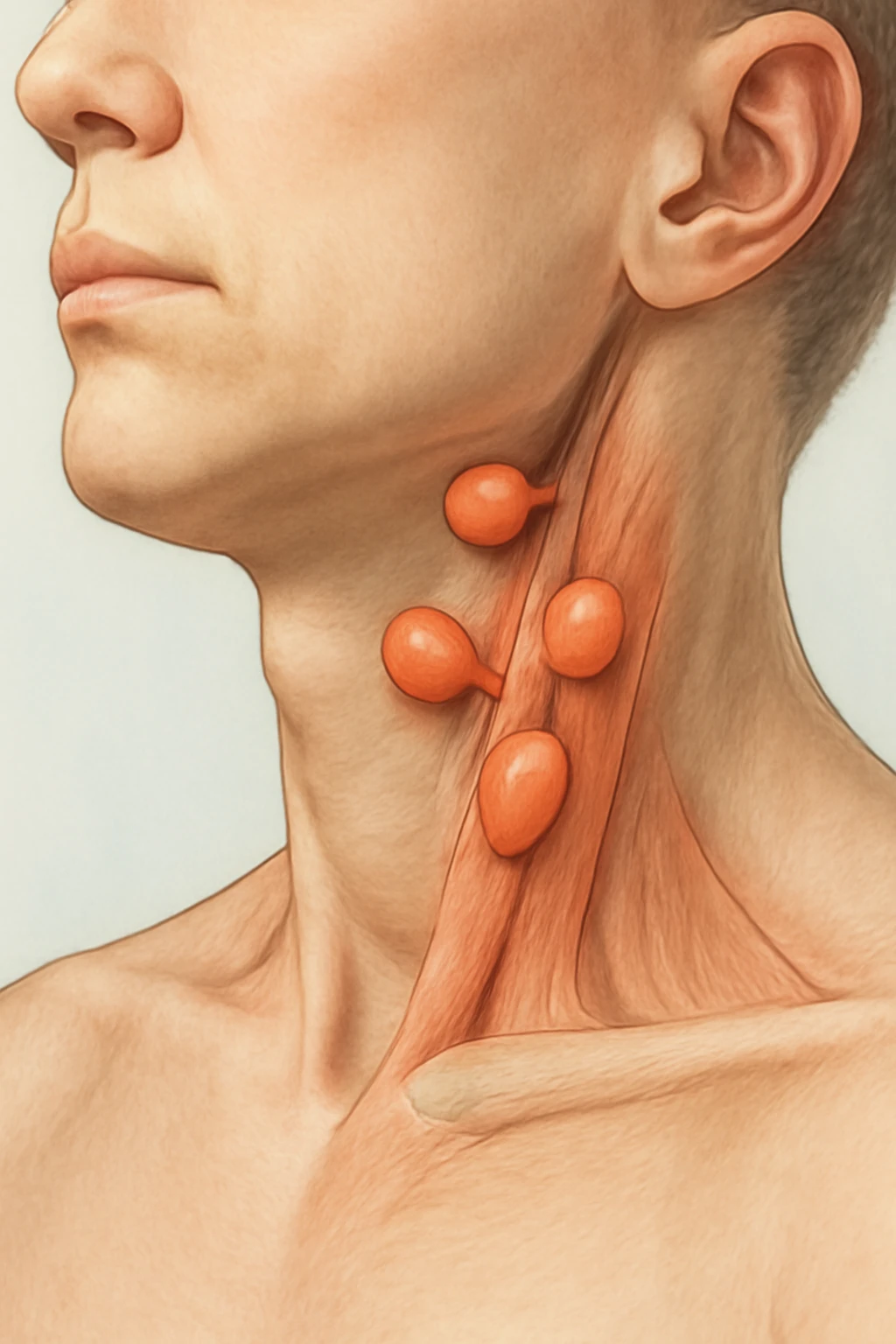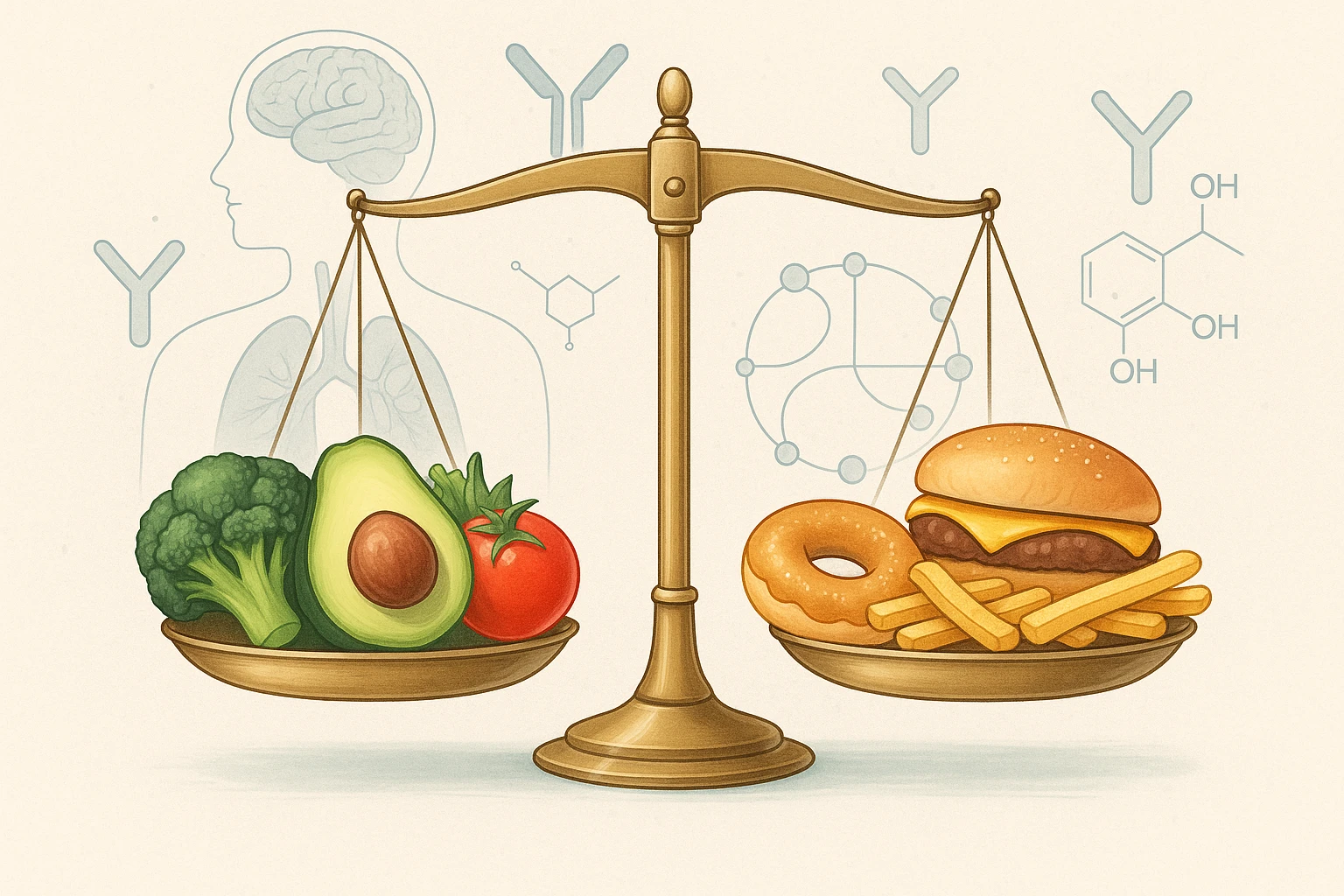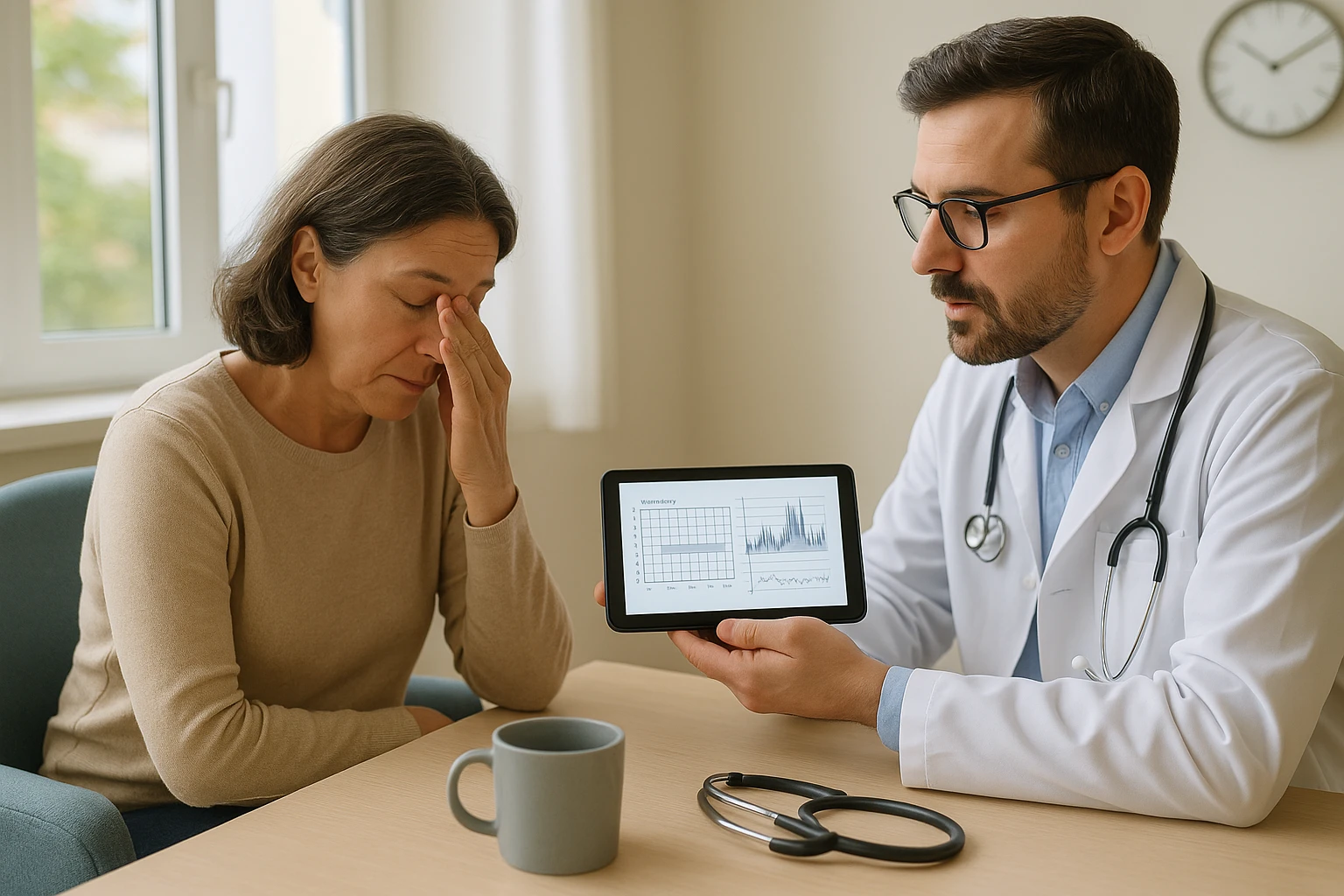How to Diagnose and Treat Swollen Lymph Nodes Effectively
Swollen Lymph Nodes: Causes and Overview
Swollen lymph nodes, also known as lymphadenopathy, occur when lymph nodes become enlarged due to various causes. Lymph nodes, which are small, bean-shaped structures found throughout the body, play a critical role in the immune system by filtering harmful substances. They are essential in fighting infections. When the body encounters infections, such as viruses or bacteria, the lymph nodes may swell as they trap and filter these pathogens.
Swollen lymph nodes are most commonly caused by infections, particularly viral ones such as the common cold, Epstein-Barr virus, or the flu. Other common causes include:
- Bacterial infections like strep throat or tuberculosis
- Autoimmune diseases such as lupus or rheumatoid arthritis
- Malignancies such as lymphoma or leukemia
- Medications, including certain antibiotics or anticonvulsants
It is important to evaluate the underlying cause of lymphadenopathy, as some conditions, such as cancer or systemic infections, may require prompt medical attention.
Common Causes of Swollen Lymph Nodes
Swollen lymph nodes are often caused by infections, particularly viral infections. However, other factors such as bacterial infections, autoimmune diseases, malignancies, and medications can also lead to lymphadenopathy. Understanding these causes is crucial for identifying the underlying condition and determining the appropriate treatment.
Infections
Viral infections are the leading cause of swollen lymph nodes. Infections like the common cold, Epstein-Barr virus (which causes mononucleosis), and the flu commonly trigger lymph node enlargement. Bacterial infections, such as streptococcal throat infections and tuberculosis, are also frequent causes. These infections activate the lymph nodes to filter out pathogens, leading to swelling.
Autoimmune Diseases
Autoimmune conditions like lupus and rheumatoid arthritis can also cause swollen lymph nodes. In these conditions, the immune system mistakenly attacks the body’s tissues, triggering inflammation that often involves the lymph nodes. The immune system’s ongoing activity in these diseases can cause the lymph nodes to enlarge as they filter and fight the immune attack.
Malignancies and Medications
Malignancies such as lymphoma or leukemia, though less common, can cause persistent lymphadenopathy. Swollen lymph nodes in cancer may signal the spread of cancerous cells. Certain medications, like phenytoin or some antibiotics, can also cause lymph nodes to enlarge due to drug-induced hypersensitivity reactions.
Recognizing Symptoms of Swollen Lymph Nodes
Swollen lymph nodes are characterized by noticeable changes, including pain, tenderness, and swelling. These symptoms can vary depending on the underlying cause of the lymphadenopathy. Symptoms are typically divided into local symptoms, involving the lymph nodes themselves, and systemic symptoms, indicating more widespread or serious conditions.
Local Symptoms
The most common local symptoms of swollen lymph nodes include pain, tenderness, and palpable swelling. Swelling occurs as lymph nodes filter out pathogens, such as bacteria or viruses. Pain or tenderness may result from inflammation within the lymph node or surrounding tissues. Local symptoms are most often seen with infections or localized inflammation, where the lymph nodes are reacting to a specific infectious or inflammatory process in the body.
Systemic Symptoms
In addition to local symptoms, swollen lymph nodes may be accompanied by systemic symptoms such as fever, night sweats, and unexplained weight loss. These symptoms may indicate more serious underlying conditions, such as cancer (e.g., lymphoma or leukemia) or systemic infections. Fever often suggests infection, while night sweats and weight loss can indicate chronic or systemic conditions, including malignancies. The presence of these symptoms should raise concern and prompt further evaluation to identify the root cause.
Diagnosis of Swollen Lymph Nodes
Diagnosing swollen lymph nodes begins with a comprehensive approach that includes a detailed patient history and physical examination. This helps healthcare providers narrow down the potential causes of the lymphadenopathy. Further diagnostic tests, such as blood tests, imaging studies, and biopsies, may be required for a definitive diagnosis, especially when the cause remains unclear after the initial evaluation.
History and Physical Examination
A thorough patient history is essential for understanding the context of swollen lymph nodes. Key information includes the duration of swelling, associated symptoms (such as fever or weight loss), and potential exposure to infections or risk factors for malignancies. The physical examination focuses on assessing the size, consistency, and tenderness of the lymph nodes. This examination can help identify whether the lymphadenopathy is localized or generalized and whether the nodes feel hard or rubbery, which can suggest different causes.
Laboratory Tests and Imaging
If the cause of swollen lymph nodes is not immediately apparent from the history and physical examination, additional tests are often required. Blood tests, such as a complete blood count (CBC) and markers of inflammation (like C-reactive protein or erythrocyte sedimentation rate), can provide insight into the presence of infection or inflammatory processes. Imaging studies, such as ultrasound or CT scans, help assess the size and location of swollen lymph nodes and may provide information about underlying conditions, such as abscesses or tumors.
Biopsy
If there is concern for malignancy or if swelling persists without a clear cause, a biopsy may be necessary. A biopsy involves the removal of a small sample of lymph node tissue, which is examined under a microscope to identify abnormal cells or pathogens. Biopsy is particularly critical when lymphoma, leukemia, or other cancers are suspected. The procedure can confirm the diagnosis and guide further treatment decisions.
Treatment and Management of Swollen Lymph Nodes
The treatment of swollen lymph nodes depends primarily on the underlying cause. A comprehensive approach is necessary to address the specific condition, whether it is an infection, autoimmune disease, or malignancy. In many cases, supportive care can help alleviate symptoms while more targeted treatments are pursued for the underlying cause.
Infectious Causes
For swollen lymph nodes caused by bacterial infections, antibiotics are commonly prescribed to target the specific pathogen. Examples include antibiotics like penicillin for streptococcal infections or more targeted agents for infections like tuberculosis. Viral infections, on the other hand, do not respond to antibiotics, so antiviral treatments may be necessary depending on the virus involved. For instance, antiviral therapy may be used for Epstein-Barr virus or other viral agents that cause lymphadenopathy.
Autoimmune Diseases and Malignancies
In cases where swollen lymph nodes are caused by autoimmune diseases such as lupus or rheumatoid arthritis, immunosuppressive therapy may be required. Medications like corticosteroids or disease-modifying antirheumatic drugs (DMARDs) are commonly used to control inflammation and immune system activity. For malignancy-related lymphadenopathy, chemotherapy, radiation therapy, or surgery may be necessary, depending on the cancer type and stage.
Supportive Care
Supportive care plays an important role in managing the symptoms of swollen lymph nodes, especially when the cause is unclear or self-limited. Pain management with warm compresses can help reduce discomfort. Nonsteroidal anti-inflammatory drugs (NSAIDs) such as ibuprofen are used to reduce pain and inflammation. Rest and hydration are also beneficial, particularly when the swelling is due to an infection.
Complications and Prognosis of Swollen Lymph Nodes
Swollen lymph nodes may resolve on their own in many cases, but untreated or mismanaged lymphadenopathy can lead to serious complications, depending on the underlying cause. If the lymphadenopathy is related to a more serious condition, such as cancer or a systemic infection, failing to address the root cause can result in disease progression and worsened outcomes.
Potential Complications
Unresolved lymphadenopathy can sometimes be indicative of an underlying malignancy, such as lymphoma or leukemia, which may require urgent treatment to prevent further spread of cancer cells. Additionally, systemic infections such as tuberculosis or HIV can cause chronic lymph node enlargement, and these conditions may lead to more severe systemic effects if left untreated.
Prognosis Based on Cause
The prognosis for swollen lymph nodes depends largely on the underlying cause. Infections often resolve with appropriate treatment, and once the infection is controlled, the lymph nodes generally return to their normal size. Autoimmune-related lymphadenopathy may improve with immunosuppressive therapy, though some patients may experience flare-ups. When lymphadenopathy is caused by malignancy, the prognosis depends on the type of cancer, its stage, and how well it responds to treatment. Early detection and intervention are critical to improving outcomes in these cases.
Treatment Options for Swollen Lymph Nodes
The treatment for swollen lymph nodes (lymphadenopathy) depends primarily on the underlying cause. A comprehensive approach is necessary to address the specific condition, whether it involves an infection, autoimmune disease, or malignancy. Supportive care can often alleviate symptoms while more targeted treatments are pursued for the underlying cause.
Infectious Causes
For swollen lymph nodes caused by bacterial infections, antibiotics are commonly prescribed to target the specific pathogen. Common examples include antibiotics like penicillin for streptococcal infections or more targeted agents for infections such as tuberculosis. Viral infections, however, do not respond to antibiotics, and antiviral treatments may be necessary depending on the virus involved. For instance, antiviral therapy may be used for Epstein-Barr virus or other viral agents that cause lymphadenopathy. In some cases, the infection resolves on its own, requiring only supportive care.
Autoimmune Diseases and Malignancies
If swollen lymph nodes are caused by autoimmune diseases like lupus or rheumatoid arthritis, immunosuppressive therapy may be required. Medications such as corticosteroids or disease-modifying antirheumatic drugs (DMARDs) are commonly used to control inflammation and immune system activity. For malignancy-related lymphadenopathy, more specialized treatments are necessary, including chemotherapy, radiation therapy, or surgery depending on the type and stage of cancer. Lymphoma, for example, may require aggressive treatment with chemotherapy or stem cell transplant, while other cancers may necessitate surgery to remove affected lymph nodes.
Supportive Care
Supportive care plays an important role in managing swollen lymph nodes, particularly when the underlying cause is unclear or self-limited. Pain management with warm compresses can help reduce discomfort associated with swollen nodes. Nonsteroidal anti-inflammatory drugs (NSAIDs), such as ibuprofen, are often used to reduce pain and inflammation. Additionally, rest and adequate hydration may assist in the recovery process, particularly when the swelling is due to an infection.
Complications and Prognosis of Swollen Lymph Nodes
Swollen lymph nodes (lymphadenopathy) may resolve on their own in many cases, but untreated or mismanaged lymphadenopathy can lead to serious complications depending on the underlying cause. If the lymphadenopathy is related to a more serious condition, such as cancer or a systemic infection, failing to address the root cause can result in disease progression and worsened outcomes.
Potential Complications
Unresolved lymphadenopathy can sometimes indicate an underlying malignancy, such as lymphoma or leukemia, which may require urgent treatment to prevent the further spread of cancer cells. Additionally, systemic infections such as tuberculosis or HIV can cause chronic lymph node enlargement, potentially leading to more severe systemic effects if left untreated.
Prognosis Based on Cause
The prognosis for swollen lymph nodes largely depends on the underlying cause. Infections often resolve with appropriate treatment, and once the infection is controlled, the lymph nodes generally return to their normal size. Autoimmune-related lymphadenopathy may improve with immunosuppressive therapy, although some patients may experience flare-ups. When lymphadenopathy is caused by malignancy, the prognosis depends on the type of cancer, its stage, and how well it responds to treatment. Early detection and intervention are critical for improving outcomes in these cases.
- Swollen lymph nodes are most often caused by infections, especially viral infections.
- Other causes include bacterial infections, autoimmune diseases, malignancies, and medications.
- Common symptoms are pain, tenderness, and swelling in the lymph nodes.
- Accompanying symptoms may include fever, night sweats, and weight loss.
- Diagnosis involves a thorough patient history and physical examination.
- Blood tests, imaging studies, and biopsy may be necessary for a definitive diagnosis.
- Treatment depends on the underlying cause of lymphadenopathy.
- Infections may be treated with antibiotics or antivirals, while cancers require more specialized treatment.
- Supportive care, such as warm compresses and pain relievers, can help manage symptoms.
- Unresolved lymphadenopathy may indicate a more serious underlying condition, such as cancer or a systemic infection.
- What are the main causes of swollen lymph nodes?
- Swollen lymph nodes are most commonly caused by infections, especially viral ones like the common cold, Epstein-Barr virus, or the flu. Other causes include bacterial infections, autoimmune diseases, malignancies, and medications.
- How can swollen lymph nodes be diagnosed?
- A thorough patient history and physical examination are essential for diagnosing swollen lymph nodes. Blood tests, imaging studies, and sometimes biopsies are used for a more definitive diagnosis.
- What symptoms indicate swollen lymph nodes?
- Common symptoms include pain, tenderness, and noticeable swelling in the lymph nodes. Systemic symptoms like fever, night sweats, and unexplained weight loss may also be present, indicating more serious conditions.
- Is there a treatment for swollen lymph nodes?
- Treatment depends on the underlying cause. Infections are often treated with antibiotics or antivirals, while cancer-related lymphadenopathy may require chemotherapy, radiation, or surgery.
- Can swollen lymph nodes be a sign of cancer?
- Yes, swollen lymph nodes can indicate a serious underlying condition such as cancer, particularly lymphoma or leukemia. Prompt diagnosis and treatment are essential in these cases.
- How long does it take for swollen lymph nodes to go down?
- The duration of swollen lymph nodes depends on the cause. Infections usually resolve within a few weeks with appropriate treatment, while swollen nodes from cancer or autoimmune diseases may persist longer.
- When should I seek medical attention for swollen lymph nodes?
- Medical attention should be sought if lymph nodes remain swollen for more than two weeks, feel hard or rubbery, or are accompanied by symptoms like fever or unexplained weight loss.
- Are swollen lymph nodes always painful?
- No, swollen lymph nodes are not always painful. Some may be painless, especially in cases of malignancy or chronic infections.
- Can swollen lymph nodes be prevented?
- There is no direct way to prevent swollen lymph nodes, as they are often a result of infections or other medical conditions. However, maintaining good hygiene and managing underlying health conditions can reduce the risk.













